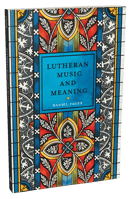Johann Sebastian Bach is a well-known name throughout the world. Whether you are a music fanatic or not, chances are you have been touched by Bach’s music without even knowing it.
Within the Lutheran church, Bach is well-known for the uniqueness he brings to our hymns with his inventive and beautiful harmonizations. As Daniel Zager, author of Lutheran Music and Meaning says, “Bach’s music reflects and proclaims the theological meaning inherent in the text. . . . No composer has ever done so more consistently, brilliantly, or beautifully.” In honor of Bach’s 338th birthday, take a look at these Lutheran Service Book: Companion to the Hymns historical facts about five hymns for which he wrote settings.
Two Christmas Hymns
Break Forth, O Beauteous Heavenly Light (LSB 378)
This Christmas hymn’s contribution comes from a trio of Johanns; text by Johann Rist (1607-67), tune by Johann Schop (1590-1667), and setting by Johann Sebastian Bach (1685-1750). The first stanza comes from Luke 2:8-18 when the shepherds are met by an angel declaring the great news of Jesus’ birth. The original text written by Johann Rist contained twelve stanzas and what we see now in our Lutheran Service Book is taken from stanzas 9, 10, and 12. Read this excerpt from Lutheran Service Book: Companion to the Hymns for even more historical context:
“The first LSB stanza, together with the tune by Johann Schop (ca. 1590 –1667), is well known from the setting by Johann Sebastian Bach in Part II of his Christmas Oratorio (BWV 248). Less well known is the hymn’s appearance in the Musicalisches Gesang-Buch edited by George Christian Schemelli in collaboration with Johann Sebastian Bach and published in Leipzig in 1736.”
O Jesus So Sweet, O Jesus So Mild (LSB 546)
This hymn is commonly sung during Christmas and features text from Galatians 4:4-5 and Romans 5:8-11. Marked as a Redeemer hymn in Lutheran Service Book, we can reflect on the gift Christ was for us. The tune sounds like a lullaby, short and light, and yet still filled with impactful words. Bach is credited for the setting on this hymn, which can best be demonstrated with this recording from Heirs of the Reformation.
In the first stanza we hear all four parts sing the melody together with the instruments adding texture and supplying harmonies, foreshadowing what will be heard by the vocals come stanza 3. In stanza 2 we hear the melody being sung with one vocalist and the instruments providing emphasis. By stanza 3 the vocals break into parts, and we hear Bach’s setting even more clearly. Notice by this point how the altos and bass take turns adding emphasis to certain parts of the text. All these elements combined through Bach’s setting bring this text to life and encourages an emotional connection to the words being sung.
A Transfiguration Hymn
‘Tis Good, Lord, to Be Here (LSB 414)
This Transfiguration hymn was written by Joseph A. Robinson (1858—1933) and the tune was by Bach. Most of Bach’s contributions to hymns is with settings, but in this instance, we have a tune written by him. (Actually, Bach originally wrote it as a keyboard piece, and it was later adapted by William Mercer into a hymn tune.) In 1888, when this hymn was written, transfiguration hymns were rare, making it even more significant. This hymn draws from the Transfiguration in Luke 9:28-36 when Peter, transfixed by what he is saying, proposes that he put up three tents so they could stay there. The hymn concludes with an appropriate prayer for God’s abiding presence among those who must “leave the mount” and return “to the plain” (stanza 5).
‘Tis good, Lord, to be here!
Yet we may not remain;
But since Thou bidst us leave the mount,
Come with us to the plain.
Isorhythmic Hymns
O Sacred Head, Now Wounded (LSB 449/450)
Found in Lutheran Service Book as hymn 449 and 450, we will be focusing on hymn 449 and the setting Bach wrote for it. The difference between these two versions can be found first, in how many stanzas there are, but the biggest difference is the rhythm that they follow. Hymn 449 is isorhythmic, while 450 is rhythmic. This distinction is important because isorhythmic is smoother in sound. Bach’s setting invites the listener and singer to connect more deeply with the words where he draws emphasis.
A Mighty Fortress Is Our God (LSB 656/657)
Another example where we see isorhythmic versus rhythmic at play is in the well-known hymn “A Mighty Fortress Is Our God” (LSB 656/657) written and composed by Martin Luther. “The hymn is often called the ‘battle hymn of the Reformation,’ but in Luther’s day it was thought of in different terms, as can be seen from the heading on an Augsburg broadsheet of 1529: ‘A hymn of comfort’ – something that was sorely needed at that time.” (Lutheran Service Book: Companion to the Hymns, 836). With this context in mind, we can see how Bach’s setting perhaps further emphasized this hymn’s original context, with comforting harmonies supporting the melody.
Portions excerpted from Lutheran Service Book: Companion to the Hymns copyright © 2019 Concordia Publishing House. All rights reserved.
 Learn more about the beauty of historic Lutheran music and how it contributes to the proclamation of the Gospel in Lutheran Music and Meaning.
Learn more about the beauty of historic Lutheran music and how it contributes to the proclamation of the Gospel in Lutheran Music and Meaning.
























